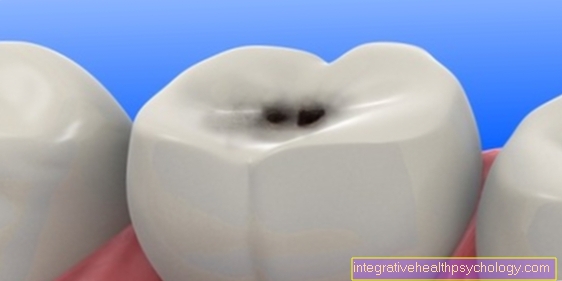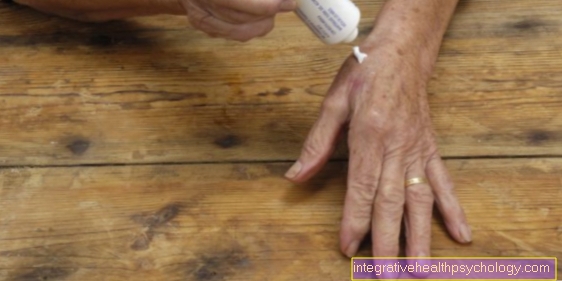Calf implants
introduction
Calf implants are usually made of silicone gel and are inserted into the fibula. There are also implants made of a more solid, more rubbery material.
They are designed in such a way that they can withstand both the muscular strain on the leg and external influences such as minor injuries and bruises.
In addition, they should visually enlarge the calf and have a uniform surface. For this purpose, smooth-walled implants are used, which are available in a smaller size and shape for women as well as a little wider and more flat for men.
The implantation of calf implants falls within the scope of plastic surgery and is performed surgically. The implantation material corresponds to that of a breast augmentation.
The calf transplantation, as well as the buttock implants, are more and more in demand these days and are constantly being further developed.
indication

The implantation of silicone pads in the calf is often done for aesthetic reasons.
There are diseases that result in an extreme narrowing of the calf muscles; this is called calf hypotrophy.
Congenital diseases include club feet, spastic paralysis or so-called spina bifida, which is a malformation in the sense of a closure disorder in the spinal column, which can also affect the spinal cord.
In addition to congenital diseases, there are also acquired calf hypotrophies, i.e. reduced or absent development of the muscles that can occur due to polio or bone inflammation. Other traumatic causes are burns, bruises, complicated fractures or even nerve injuries that cause the muscles to recede.
Even bodybuilders who are not satisfied with the shape and shape of their calf muscles despite intensive muscle training often consider calf implants.
Pretreatment
Before an operative enlargement of the calves is carried out, a precise anamnesis and preliminary examination by the attending physician is useful. The patient's ideas and wishes should be compared with the realistic treatment goals to be expected.
It is also important that the patient is aware of the Risks of the operation and over alternative therapy options is cleared up. If the patient then decides to have the procedure, an appointment for the operation should be scheduled.
About two weeks before this appointment, the patient may need to stop taking some medication. This is especially true at blood-thinning drugs and Painkillers important. In addition, the patient should not consume alcohol or nicotine during this period.
Procedure
The calf implantation is a surgical procedure that must be carried out in an inpatient hospital. The intervention can take place general anesthetic or one Anesthesia of the spinal cord occur.
Depending on whether only the inner or the outer part of the calf is to be enlarged, a different incision is made.
Often only the inner part is provided with an implant. To do this, the surgeon makes an incision about four centimeters long either on the inside or on the outside of the hollow of the knee.
If both sides are enlarged, a slightly wider horizontal cut is made. The implant is placed on the Gastrocnemius muscle placed. This is a two-part muscle on the surface of the fibula. It is prepared for this by removing its fascia, a thin layer of connective tissue that rests directly on the muscle, so that the implant rests directly on the muscle tissue.
If a patient, in most cases a bodybuilder, wants the gastrocnemius muscle to remain visible with your two muscle tummies, the implant can also be placed under the muscle heads.
The wound is then sewn up in several layers and closed. She is also provided with a light wrap bandage and, if necessary, a support stocking. Of the Support stocking and an additional Heparin administration serve the Thrombosis prophylaxis.
Depending on the degree of mobilization, this must be maintained for a few days after the operation.
In general, the patient should not put too much strain on his legs after the operation and should only cover short distances with the help of aids and supports.
Exercise may also only be started again carefully after six weeks.
Despite careful surgery and adherence to hygiene measures, numerous side effects can occur after the operation.
Every surgery carries risks to the whole body, which among other things Thrombosis, Embolisms and severe post-operative pain consist.
There are special risks involved in calf implantation, as a foreign body has been implanted, so the patient has to go along with it Swelling and irritations count in the area of the leg and foot.
It can also Bruising or Fluid build-up which can be avoided by wearing support stockings and, if necessary, by laying drains.
Also the risk for one post-operative infection of the wound and a Hardening of the implant cannot be ruled out.
In rare cases, the implant can shift and thus above all an optical disruptive factor or the silicone of the silicone cushion can even leak out of the wound.
Therapy alternatives
In addition to the implantation of silicone implants, a transplant of endogenous fat be considered. However, this is a rather seldom chosen surgical method, as the calf does not appear muscular and defined after the transplantation, but rather even and massive.
Advantages of autologous fat transplantation are one little scarring and a very good compatibility, since the body's own material is used here and there is no immune reaction. In addition, the enlargement of the calf can be made even closer to the patient's request, since he can determine the amount to be injected himself.
However, the injection must be repeated a few times every six months until the desired target is achieved, as the body breaks down part of the injected fat or uses it in another way.
In addition, there are also non-surgical measures to enlarge the calf muscles. If there is no genetic defect, it is often sufficient to have a few muscular exercises to make the calf muscles stronger and also a high protein diet to choose.
This includes all exercises that require strength development in order to tip your toes. This includes everyday situations such as climbing stairs, which can be easily carried out.
Another therapy option is treatment with the drug Macrolane, a very strongly cross-linked hyaluronic acid, which can be used to fill up and gain mass in various parts of the body. To do this, the affected body region is injected with the drug and should immediately trigger the desired change.
The procedure can be done on an outpatient basis and is carried out with the additional administration of local narcotics carried out. This treatment also leaves no scars. Since the body breaks down the hyaluronic acid, the calf shrinks again after a while, so that the procedure has to be repeated every two years for a permanent result.
Types of implants
The most commonly used implant is that Silicone gel, which usually has a firm and smooth surface that offers a good grip so that the implant can be inserted particularly deep into the calf through the very small surgical incisions.
In addition, between anatomical and spindle-shaped calf implants distinguished.
The anatomical implants are larger and have a roughened surface on one side. They are preferred in cases of reduced muscle development from birth or in male patients.
The spindle-shaped implants, on the other hand, are less dominant and are used in women. They can be used to correct any area of the calf, whereas anatomical implants are only recommended for the upper calf section.
There are standardized shapes for calf implants and those that are made from a plaster cast and that can be individually adapted and also changed after the operation. However, these implants are significantly more expensive and complex and are usually stronger so that they can be felt from the outside in the calf after the operation.
The silicone gel implants are called not harmful to health classified and should not affect the body in its balance. The basic material silicone is used in other areas of medicine and is generally considered to be very well researched and harmless.
In America in particular, there have been many studies that refuted the suspicion that silicone is responsible for the development of various diseases.
In special cases, such as burns or severe injuries, so-called Calf expanders can be used. These are initially empty shells made of silicone, which have a valve that is implanted just below the skin surface and via which the size of the implants can be varied.
At weekly intervals, saline solution can now be filled into the expander via the valve, so that the cover expands further and space is created for inserting a final transplant. This therapy lasts up to six weeks and is indicated when there is a lack of tissue.
Aftercare
After the operation, caution should be exercised when loading the leg, but the patient should no longer be restricted after a few weeks. He can do sports as well as withstand any other type of physical stress and should not find the implant disturbing.
A follow-up examination with a follow-up treatment is at Pain, massive redness and Swelling, increased scarring and Growths or at Trauma necessary.
Should the implant disturb the patient, it is possible that it has to be replaced or repositioned. As a rule, however, no further operation is necessary, so that the silicone gel implant can remain in the calf for life.
costs
As already mentioned, the indication for a calf implantation is usually one cosmetic treatmentthat is supposed to trigger an aesthetic change. In these cases the treatment is not directly medically indicated and therefore the patient is the sole cost bearer for the operation, the inpatient stay, the pre- and follow-up examinations and the material costs.
A routine procedure without any further complications will result in costs of around two to three thousand euros. In addition, there are usually the costs for the implant of around seven hundred euros.
Is the treatment by a disease-related muscle hypotrophy conditionally, takes over Health insurance the costs proportionately or even entirely. If a reoperation is required, however, in most cases the patient is the sole cost bearer.























.jpg)





